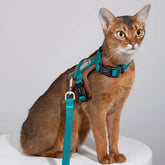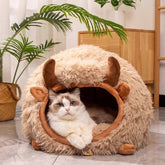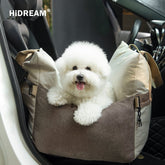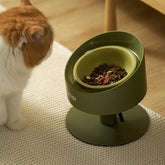Playtime and Enrichment: Keeping Cats Happy and Stimulated

Cats are fascinating creatures, known for their independence and curiosity. While they may seem aloof, they need mental and physical stimulation for a happy life. Playtime and enrichment are essential for their overall well-being, promoting physical health, mental sharpness, and emotional satisfaction. In this guide, we'll explore the importance of play and enrichment, providing practical tips to strengthen the bond with your cat and ensure they lead a content and fulfilled life. Playtime lets cats express their natural instincts and keeps them agile, while enrichment activities create a stimulating indoor environment. Together, we'll make playtime and enrichment a vital part of your cat's daily life, fostering a harmonious and lasting relationship.

The Importance of Play for Cats
Playtime is an essential aspect of a cat's life, mirroring their instincts as natural hunters. Engaging in play mimics the thrill of stalking prey, allowing cats to release pent-up energy and stimulate their minds. Regular play sessions are vital, especially for indoor cats, as they lack the opportunity to explore and hunt outdoors. Playtime not only prevents obesity and boredom-related behavioral issues but also strengthens the bond between cat and owner. By actively participating in interactive play, cat owners build trust and affection with their feline companions, enhancing the quality of their relationship.
Pros of Play for Cats
Physical Exercise
Playtime provides cats with the opportunity to engage in physical activities, promoting agility, strength, and overall physical health. Regular play can help prevent obesity, which is a common health issue in indoor cats.
Mental Stimulation
Play stimulates a cat's mind, allowing them to use their problem-solving and hunting instincts. Engaging in interactive play and puzzle games keeps their minds sharp and helps alleviate boredom, reducing the risk of behavioral problems.
Bonding and Social Interaction
Interactive play with their human companions strengthens the bond between cats and their owners. It also satisfies a cat's social needs, enhancing their emotional well-being and reducing anxiety.
Stress Reduction
Play can serve as a stress-relieving activity for cats, helping them relax and unwind. It can be particularly beneficial for cats experiencing changes in their environment or coping with stressful situations.
Prevents Destructive Behavior
By providing cats with appropriate outlets for their energy, playtime can deter them from engaging in destructive behaviors like scratching furniture or inappropriate chewing.

Cons of Play for Cats
Overstimulation
Cats can become overstimulated during play, leading to aggression or negative behavior. Recognizing the signs of overstimulation is crucial to stopping play sessions before they escalate.
Risk of Injury
During vigorous play, there is a risk of accidental scratches or bites, especially if the cat becomes overly excited or aggressive. Cat owners should be cautious and mindful of their cat's body language during play.
Inappropriate Play Targets
Without proper guidance, cats may redirect their hunting instincts towards inappropriate targets, such as other pets, small children, or vulnerable animals. Ensuring that play is directed towards appropriate toys is essential.
Playtime Dependency
In some cases, cats may become overly dependent on playtime for stimulation, leading to behavioral issues when they do not receive enough play sessions. It's essential to strike a balance between play and other forms of enrichment.
Environmental Hazards
If cat owners use toys or objects that are potentially hazardous or have small, ingestible parts, there is a risk of accidental ingestion or choking. Providing safe and appropriate toys is crucial to ensure the cat's safety during play.

Understanding the Types of Play
Cats engage in different types of play, each serving a specific purpose in their physical and mental development. Predatory play involves stalking, pouncing, and chasing toys, resembling a cat's natural hunting behavior. Interactive play with their human companions strengthens the human-cat bond while satisfying their need for social interaction. Understanding these play types enables cat owners to provide a diverse range of activities that cater to their cats' specific preferences and instincts.
Predatory Play
Mimicking hunting behaviors, cats engage in stalking, pouncing, and chasing activities with interactive toys.
Interactive Play
Strengthening the bond with their human companions, cats engage in playtime that involves social interaction and games.
Solo Play
Cats entertain themselves with various toys, such as balls, puzzle feeders, and catnip-infused objects.
Object Play
Cats amuse themselves with everyday objects like cardboard boxes, paper bags, or crumpled paper.
Locomotor Play
Displaying their agility, cats run, leap, and jump during this type of physical play.
Puzzle Play
Challenging their minds, cats engage in activities that require problem-solving skills, such as puzzle feeders and food-dispensing toys.
Climbing and Scratching Play
Satisfying their natural instincts, cats climb on cat trees and use scratching posts to maintain their claws and explore their environment.

Enrichment Activities for Indoor Cats
Indoor cats, in particular, benefit greatly from enrichment activities that replicate the stimulation they would experience outdoors. Cat owners can create a stimulating environment by introducing:
Puzzle Feeders
Provide mental stimulation and mimic hunting behavior by using food-dispensing toys or puzzle feeders.
Vertical Spaces
Install cat trees, shelves, or window perches to offer climbing opportunities and a vantage point for observing the environment.
Interactive Toys
Engage indoor cats with interactive toys like feather wands, laser pointers, or toys on strings for playtime with their owners.
Cardboard Boxes and Paper Bags
Offer simple and inexpensive play options with empty cardboard boxes or paper bags that cats love to explore and hide in.
Scratching Posts and Pads
Provide designated scratching areas to fulfill the natural instinct to scratch and keep their claws healthy.
Rotating Toys
Keep indoor cats entertained by rotating their toys regularly to maintain their interest and prevent boredom.
Playtime with Other Cats
Arrange playdates with other friendly cats to provide social interaction and companionship.
Laser Chasing
Engage cats with laser pointers to stimulate their chasing instincts, but always end the play with a physical toy or treat to satisfy their hunting drive.

DIY Toys and Games
Engaging in DIY toys and games not only saves costs but also adds a personal touch to your cat's playtime. Simple household items, such as cardboard boxes, paper bags, and crumpled paper, can become intriguing toys for cats to explore. Creating homemade puzzle feeders using toilet paper rolls or egg cartons challenges their problem-solving skills and adds an element of excitement to mealtime. Spending quality time crafting toys for your cat can be a fulfilling and enjoyable activity for both of you.
Crinkle Tunnel
Create a fun and interactive toy by cutting holes in a cardboard box or paper bag and lining it with crinkled paper for cats to explore and play in.
Feather Wand
Attach feathers or fabric to a string or stick for an engaging and interactive play session with your cat.
Catnip Sock Toy
Fill a clean sock with catnip and secure the end to make a simple catnip-filled toy for your feline friend.
Toilet Paper Roll Treat Dispenser
Stuff treats or dry food inside a toilet paper roll and fold the ends to create a DIY treat dispenser that encourages problem-solving during playtime.
Ping Pong Ball Chase
Place a ping pong ball inside a bathtub or shallow box, and watch as your cat enjoys chasing and batting it around.
Cardboard Puzzle Box
Cut holes of various sizes in a cardboard box, and hide treats or toys inside to create a puzzle box that challenges your cat's hunting and problem-solving skills.

The Role of Catnip and Cat Grass
Catnip is a herb that contains nepetalactone which produces a euphoric response in cats, inducing playfulness and excitement. Offering catnip-infused toys or introducing catnip plants can be a delightful addition to playtime.
Cat grass for example such as wheatgrass or oat grass, provides a natural and safe alternative, offering a sensory and edible experience that many cats enjoy. However, not all cats are affected by catnip; some may even show no interest.
Stress Relief
Catnip can have a calming effect on cats, reducing anxiety and stress in various situations, such as during vet visits or when adjusting to a new environment.
Enrichment and Play
Catnip can enhance playtime by stuffing toys or scratching posts with it, encouraging cats to engage in interactive and stimulating play.
Digestive Aid
Cat grass, like wheatgrass or oat grass, acts as a natural laxative when ingested by cats, helping with digestion and reducing hairballs.
Safe and Edible Indulgence
Cat grass provides a safe and enjoyable alternative for cats to munch on, satisfying their natural urge to chew on plants without risking toxic exposure.

Setting a Playtime Schedule
Consistency is key when it comes to playtime and enrichment for cats. Establishing a daily playtime schedule helps cats anticipate and look forward to engaging activities regularly. Set aside specific times during the day for interactive play and enrichment activities, ensuring that your cat receives adequate physical and mental stimulation. A routine not only keeps the cat physically active but also promotes a sense of security and predictability in their daily lives.

Spotting when your cat's had enough play
As much as cats enjoy playtime, they can become overstimulated or exhausted. Cat owners must be mindful of their cat's body language and recognize signs of fatigue or irritability. If the cat starts to exhibit aggressive behaviors, withdraws, or shows signs of stress, it's crucial to stop the play session and provide a calm and quiet space for them to relax.
Conclusion
Playtime and enrichment are essential elements in providing a happy and stimulating life for our beloved feline companions. By understanding the significance of play in a cat's life and offering a diverse range of interactive and DIY toys, we can keep our cats physically and mentally engaged. Enrichment activities for indoor cats create a stimulating environment that replicates the excitement of the outdoors, fostering a sense of contentment and well-being. Through regular playtime, we not only strengthen the bond with our cats but also enhance their quality of life, making every moment spent together a joyful and fulfilling experience for both cat and owner. So, let's embrace playtime and enrichment as vital components of responsible cat ownership, ensuring that our feline friends lead happy, healthy, and enriched lives in our care.























